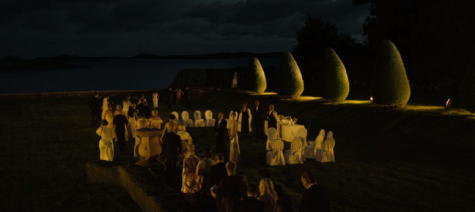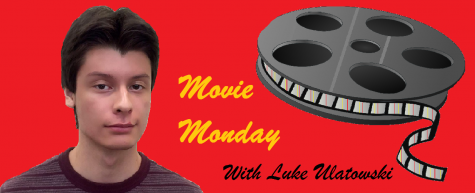Movie Monday with Luke: “Melancholia” evenly separates its hits, misses
October 19, 2015
These days, you probably know Danish film director Lars von Trier for 2013’s “Nymphomaniac,” a two-part borderline pornographic drama advertised with the O-faces of Shia LaBeouf and the rest of its famous cast members. Back when 2011’s “Melancholia” came out, people knew him for declaring himself a Nazi and getting banned from Cannes. Yes, he’s that kind of director: an artsy provocateur with the budget to make a splash. “Melancholia” is one of his more restrained efforts, but could probably benefit from being even more so.
The first part of “Melancholia” documents the wedding reception of a woman named Justine (Kirsten Dunst). It’s a beautiful party sponsored by her rich brother-in-law John (Kiefer Sutherland), and it should be the best day of her life, as everyone’s quick to let her know. Too bad her new husband (Alexander Skarsgård) is the blandest, most clueless man on Earth, her mother (Charlotte Rampling) is a selfish, scene-making prick, her father (John Hurt) couldn’t care less about her, her boss (Stellan Skarsgård) will not quit hounding her for more work and she is almost literally crippled with depression. Meanwhile, unbeknownst to all, another planet is hurtling toward Earth. The second part follows Justine’s sister Claire (Charlotte Gainsbourg) as she tries to cope with the implications of the planet’s presence, dubbed Melancholia.
First of all, I’d like to note how this synopsis is a lot shorter than Wikipedia’s, which notes how every character is a personification of a Freudian concept and labels each one with evidence to back it up. None of that is important. One might say each character holds a deeper meaning, but what they really hold is but an unstated title. Justine’s mother may represent honesty, but that concept is only presented through her statements of “I hate marriage” and the like. It’s not explored through any two-dimensional interactions nor elaborations on what got her to that point; in fact, along with much of the film’s cast, she disappears halfway through without closure. Organizing characters with specific labels that highly differentiate them can be a good tool for writing, but it isn’t good writing in and of itself, just like arranging your markers by the colors of the rainbow isn’t good drawing.
This film might be considered safer than von Trier’s other films, which more often than not include loads of sex and the occasional helping of gore. “Melancholia” benefits from never going too far whilst retaining a certain edge from the doom looming overhead throughout the entire film. At the same time, it’s not safe at all. The doomsday framing device brings one huge question with it: In the context of the end of the world, is what we’re seeing actually important? We’re not focusing on heroes, scientists, world leaders, crazed masses tearing up the streets nor criminals making their last ditch efforts whatsoever. To ensure this, the film explicitly bars the central two characters and the camera from leaving the resort at which the reception takes place. It’s a bold, admirable move, but does it work? For the most part.
To give the story the weight it calls for, the film channels the viewer’s omnipresent little frustration with the film’s mundane topic. There are several scenes of irritating repetition. At the beginning, Justine, her husband and their driver struggle to get their limousine past a curve for a good three minutes of the film’s run. Later, Justine’s father pulls an annoying prank on a waiter, gaining courtesy laughs, only to repeat the same prank on the same person immediately after. Justine has a fake smile on through it all. You relate to her, even through your viewing experience alone. Throughout the reception, characters say things Justine wishes they wouldn’t, then corner her about her feelings on her big day. It feels off, but really thinking about it, everything that happens inside that hall is actually very average. It’s a genuine, all-too-relatable discomfort that surpasses what could have been accomplished with less nuance.

What goes on outside the party isn’t quite the same. Whenever Justine steps outside to the golf course, the film frees itself to gain a soundtrack (exclusively relegated to the fittingly melancholic prelude to Richard Wagner’s “Tristan and Isolde”), gorgeous imagery and some less believable plot developments. The disparity is felt; it’s Justine’s escape, and later on, Claire’s. Yet, under the confines of the plot, neither of them can actually leave the resort. It’s just another box over the box they were previously in.
With the wider doomsday plot, this concept only expands further; running may bring momentary relief, but ultimately, there is no escape. These ideas are communicated very well in the story proper, but they can feel redundant after the opening scene, an artsy mish-mash of all of the film’s motifs. It’s just self-indulgent. It’s the kind of thing to which a writing professor would say “Cut this! You don’t need this!” The only part necessary for our enjoyment of the rest of the film, our preview of the end of the world, could be even more gripping as the sole component of the opening scene.
The first part is successful in evoking the emotions it wants. However, the second part loses color. It abandons the distinct settings and rigid, contained structure of the first part, taking place in loose settings throughout the resort over the course of an unclear amount of time. While the first part is focused and packed with information, the second part waddles off into nowhere. The funny thing is, the doomsday plot only comes into play in the second part. The viewer would not be aware of it at all in the first part were it not for the opening scene. The film explicitly ignores the science of a planet on a crash course toward Earth, so it should have taken further liberties in order to condense the film. The entire film could have taken place during the reception as the first part did, still ending with the crash; the tension would pay off, and with more of the characters present, that final moment would be more powerful.
With its clear dialogue and straightforward presentation of motifs, the film doesn’t ask all that much of the viewer, mostly their suspension of disbelief. This regards the doomsday planet, of course, but also its portrayal of depression. Von Trier was inspired to make the film by a bout of severe depression, so it’s safe to assume this portrayal is the central aspect of the film. Unfortunately, it’s hard to buy. Justine is very easily relatable in the first part, but in the second part after her breakdown, she’s treated as some sort of sage. She lounges around as Claire hyperventilates, speaking in vague riddles with a perfectly straight face. The second part of the film is about the differences between the reactions a depressed person has to catastrophe compared to their peers, but it doesn’t really explore the concept, only presenting Justine as the wise, sane one and Claire as the hysterical one. It’s an awkward message that’s hard to gain anything from, and it’s disappointing that it’s all the first part was building up to.
SHOULD YOU WATCH IT? Throughout the first half, I was planning on saying “Yes” straightforwardly, but “Melancholia” is one of the most evenly separated hit-and-miss films in recent memory. The build-up is intriguing, if misleading, while the payoff is a flat, overdrawn tract. Watch it if you’re willing to sacrifice a little time.
WATCH IF YOU LIKE: The film’s 2011 Cannes rival “The Tree of Life” from Terrence Malick.



Julie Bender • Oct 19, 2015 at 6:27 pm
I agree, although I really hated this movie! Fantastic, spot-on review.